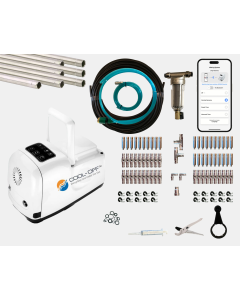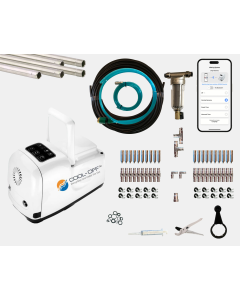High Pressure Misting Systems
-
 15' - 25' Nylon Tubing High Pressure Misting System Kit w/ Remote (7-12 Nozzles)Special Price $649.00 Regular Price $1,695.00Quickview
15' - 25' Nylon Tubing High Pressure Misting System Kit w/ Remote (7-12 Nozzles)Special Price $649.00 Regular Price $1,695.00Quickview -
 25’ Stainless Steel High Pressure Misting System Kit w/remote - (15 Misting Nozzles)Special Price $929.99 Regular Price $2,495.00Quickview
25’ Stainless Steel High Pressure Misting System Kit w/remote - (15 Misting Nozzles)Special Price $929.99 Regular Price $2,495.00Quickview -
 60' High Pressure Misting System Kit w/App Control Pump - (30 Misting Nozzles)Special Price $1,495.00 Regular Price $3,295.00Quickview
60' High Pressure Misting System Kit w/App Control Pump - (30 Misting Nozzles)Special Price $1,495.00 Regular Price $3,295.00Quickview -
 40' High Pressure Misting System Kit w/App Control Pump - (20 Misting Nozzles)Special Price $1,295.00 Regular Price $2,795.00Quickview
40' High Pressure Misting System Kit w/App Control Pump - (20 Misting Nozzles)Special Price $1,295.00 Regular Price $2,795.00Quickview -
 80’ High Pressure Misting System Kit w/App Control Pump - (40 Misting Nozzles)Special Price $1,595.00 Regular Price $3,795.00Quickview
80’ High Pressure Misting System Kit w/App Control Pump - (40 Misting Nozzles)Special Price $1,595.00 Regular Price $3,795.00Quickview -
 100’ High Pressure Misting System Kit w/App Control Pump - (50 Misting Nozzles)Special Price $1,995.00 Regular Price $4,495.00Quickview
100’ High Pressure Misting System Kit w/App Control Pump - (50 Misting Nozzles)Special Price $1,995.00 Regular Price $4,495.00Quickview -
 150' High Pressure Misting System Kit w/Remote Control Pump - (65 Misting Nozzles)Special Price $2,545.00 Regular Price $4,795.00Quickview
150' High Pressure Misting System Kit w/Remote Control Pump - (65 Misting Nozzles)Special Price $2,545.00 Regular Price $4,795.00Quickview -
 200' Mega Mist High Pressure Misting System Kit - (80 Misting Nozzles)Special Price $3,295.00 Regular Price $5,995.00Quickview
200' Mega Mist High Pressure Misting System Kit - (80 Misting Nozzles)Special Price $3,295.00 Regular Price $5,995.00Quickview -
 350' Ultra Mega Mist High Pressure Misting KitSpecial Price $4,995.00 Regular Price $7,895.00Quickview
350' Ultra Mega Mist High Pressure Misting KitSpecial Price $4,995.00 Regular Price $7,895.00Quickview
High Pressure Misting Systems
Nowhere is the saying “You get what you pay for” more appropriate than with High Pressure Misting Systems. Surely all mist systems have a nice cooling effect on people, animals, and areas under heat stress; that is, the ambient temperature will be reduced. The reduction is effected by humidity and by the temperature of the mist being put out.
The use of high pressure mist offers a number of significant advantages over low pressure misters and even mid pressure mist systems:
First and foremost, high pressure (defined as 800 PSI or greater) allows the use of smaller orifice nozzles which allow smaller water particulate size and of course quicker evaporation. Some high pressure system pumps can increase the pressure well over 1000 PSI, but that has no impact on the mist size. Only the orifice of the nozzle does this. For example, a low pressure system (say 60 PSI) will activate a .015” size nozzle, but not smaller. A mid pressure systems (180-200 PSI) will activate a .012” nozzle. High pressure systems easily power up .006 or .008 nozzles with a beautiful hollow cone mist pattern.
A major advantage of high pressure mist is that it does not lose pressure over long line runs or with many nozzles in line. You will see the same beautiful spray pattern at the end of the mist line as at the beginning. Low and mid pressure systems tend to lose their uniform spray when more than 25 nozzles are used or when there are hard 90 degree turns in the water flow.
High pressure mist has numerous applications in various settings, best categorized as Commercial, Industrial, or Residential. Commercial opportunities include humidification of greenhouses, odor and dust control of refuse plants, and of course, chilling outdoor patios with the smallest possible nozzle. In social settings, there can be a very low tolerance for excess wetting of floors, equipment, and especially patrons. High pressure does a fantastic job of quickly evaporating and producing the great temperature reduction, especially in drier climates.
Eliminate Workplace Heat Stress
For industry, our high pressure mist is used for humidification, allowing more efficiency in print operations. More importantly, it can be a life saver in eliminating heat stress for workers which eliminates OSHA (Occupational Safety and Health) issues, and also keeps workers more attentive and motivated on the job.
In residences, high-pressure mist lines are renowned for creating an attractive and inviting look while chilling shaded patios by up to 25 degrees. Stainless steel lines with compression fittings and nozzles spaced every 24 inches are considered standard fare. Fogscaping is a very popular misting effect around pool grotto areas or with lighting on for a dramatic effect.
High pressure pumps should be sized to the project at hand. As the average output per nozzle is about 1 gallon per hour, be careful to have the pump that handles that flow properly without much excess capacity which can lead to overheating of the seals and reduced pump life.



